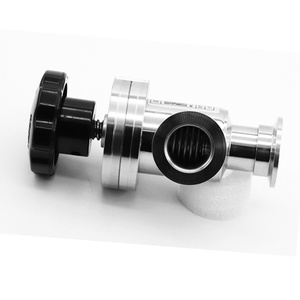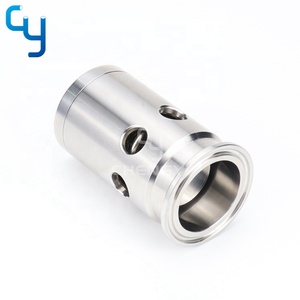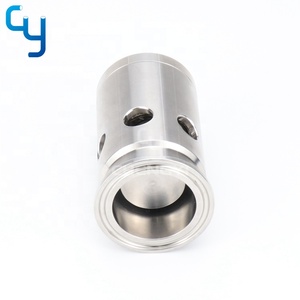
All categories
Featured selections
Trade Assurance
Buyer Central
Help Center
Get the app
Become a supplier

(1663 products available)



















Market Overview: The global vacuum adjustment valve market is on a robust growth trajectory, with a significant increase in demand anticipated. As of 2023, the market was valued at approximately USD 1.76 billion and is projected to reach USD 3.33 billion by 2030, reflecting a remarkable CAGR of 9.51% according to 360iResearch™. This growth can be attributed to the rising adoption of vacuum systems across various industries, including automotive and manufacturing, where precision control is crucial. The market for industrial vacuum valves, which includes vacuum adjustment valves, is also experiencing growth, estimated at USD 1.4 billion in 2023 and forecasted to reach USD 1.9 billion by 2030, with a CAGR of 4.7% according to Global Industry Analysts, Inc.
Industry Dynamics: Key drivers of the vacuum adjustment valve market include technological advancements that enhance efficiency and reliability, alongside increasing safety and environmental regulations. The U.S. market for vacuum valves was valued at USD 372.7 million in 2023, with a notable growth forecast in China, which is expected to grow at a 7.7% CAGR, reaching USD 386.9 million by 2030. Additionally, shifts in consumer behavior towards automation and improved operational efficiency are influencing purchasing decisions. Major players in this sector are focusing on innovative solutions to meet the evolving demands of industries, thereby enhancing their market share. As industries increasingly prioritize automation and process optimization, vacuum adjustment valves are positioned to play a pivotal role in future technological advancements.
Vacuum adjustment valves are critical in generating the precise pressure differentials required for maximum performance in various industrial operations. The precise pressure differentials required for optimal performance in various industrial operations are produced by vacuum control valves.
These constituents can be segregated into several classes depending on the variety of functioning principle and application parameters.
Electro-Pneumatic Adjusting Valves
For operations requiring precise control in an electronically integrated context, electro-pneumatic vacuum control valves are very suitable. These components use electronic impulses to control pneumatic signals, producing very accurate vacuum adjustments. They adjust the vacuum force with remarkable accuracy by converting electrical input into controlled pneumatic output. Their utility is widespread in the electronic, aviation, and medical industries.
Mechanical Vacuum Adjustment Valves
The operation of the mechanical vacuum adjustment valve does not require any electrical elements. Instead, it uses springs and bellows to measure and control the vacuum levels adjustment. Although these valves are not as accurate as their electro-pneumatic counterparts, they are very robust and reliable in low-tech environments or places where electronic components cannot work properly. The automotive sectors, along with several other industries, employ these valves for routine vacuum regulation.
Electronic Vacuum Control Valves (EVCVs)
EVCVs are used in applications where precise electronic control can significantly improve functionality. These devices manage the vacuum by modulating an electronic signal, which is crucial in industries such as vehicle emission management. In auto-control systems, for instance, EVCVs control the intake manifold vacuum, improving engine performance by modifying the throttle position based on real-time engine parameters.
Vacuum Relief Valves
Vacuum relief valves are essential safety devices that prevent the development of excess vacuum pressure in a system. These valves work by letting in atmospheric air or another outside fluid once the internal vacuum falls below a particular threshold, thus reestablishing pressure equilibrium. In pharmaceutical and food processing plants, vacuum relief valves are extremely important in avoiding container deformation and product contamination as a function of pressure differentials.
Control, safety, and efficiency in vacuum-sensitive industrial operations are possible through vacuum adjustment valve functionality in various operations.
High Precision Operation
In many sectors, the primary function of vacuum adjustment valves is to ensure high control precision. The precision with which these valves can modify the vacuum levels is critical in such areas as pharmaceuticals, electronics, and aeronautics, where tiny changes can cause differing outcomes. Electro-pneumatic vacuum control valves offer high precision due to their computerized control mechanisms, accurately modifying vacuum points according to setpoint values.
Robust Construction
Vacuum adjustment valves are designed to be robustly constructed so their constant performance can occur even in extreme operating conditions. Premium metal alloys or other sturdy materials are used relentlessly in the vacuum-sealed environment to ensure durability. Additionally, exposure to chemicals or high-temperature elements requires these valves to endure corrosion and heat, with design features important in this regard that enhance their robustness.
Integration with Automation Systems
Many sectors today use automated control systems to increase efficiency. For this reason, vacuum adjustment valves are often designed to integrate with these systems. Through real-time monitoring and control, the vacuum control valves cooperate with PLC and other automated systems. This synergy improves the process control and reduction in the need for manual intervention, thus contributing to total operational efficiency.
Safety Features
Many industries depend on the safety characteristics of vacuum adjustment valves, particularly those that deal with dangerous chemicals or sensitive goods. Vacuum relief valves help prevent over-vacuum situations, which could cause device failure or, even worse, an explosion in a contained environment. Besides pressure control, many valves include fail-safe designs, which ensure that the valve works as desired, even if a malfunction happens.
Apart from functionality, durability, and safety in industrial uses, choosing the right vacuum adjustment valves is fundamental to optimize operational efficiency in an unstable vacuum environment.
Operating Vacuum Range
The operating range of the vacuum to which the valve will be exposed during usage must be well understood. The vacuum adjustment valve ought to be able to withstand the whole gamut of vacuum levels inherent in the experimental process. The specific vacuum fluctuation range must be compatible with the valve's material and construction so that valve failure does not occur through exposure to extremes.
Material Compatibility
The materials constitutive of vacuum adjustment valves should be compatible with the substances used in the system to prevent premature valve failure. The internal construction materials see continuous exposure to chemicals or corrosive elements in many industries, hindering their optimal maintenance. Selecting vacuum adjustment valves in the proper materials ensures durability, reliability, and lower maintenance costs.
Response Time and Sensitivity
In processes where adjustments require inordinately quick or highly sensitive responses, the vacuum control valve must possess excellent response time and sensitivity. These characteristics are crucial when the process demands that even small fluctuations in vacuum undergo quick adjustments immediately. Electro-pneumatic syringe control valves, which can offer superior sensitivity and rapid responses, are valuable in operations wherein precision assumes critical importance.
Size and Installation
The size of the vacuum adjustment valve must be appropriate for the deemed system installation. The placement of the valve in the system influences its dimensions in such a way that valves located in tight spots should offer compact design. Also, installation should be considered; some valves may be more easily fitted into existing systems than others, especially when modifications are required.
Vacuum adjustment valves should be properly maintained to ensure reliability, efficiency, and the all-important longevity of their contained elements in sensitive industrial uses. Proper maintenance ensures the valve's intended operating characteristics for as long as possible while keeping the experimental process free of the possible complications associated with vacuum fluctuation.
Regular Calibration
In processes requiring extreme precision, vacuum adjustment valves must continually be calibrated to ensure that the expected values equal the realized ones. This involves comparing the valve's output with a standard measurement and adjusting it appropriately. In many electronic control systems, vacuum calibration is done at regular intervals to maintain the precision of the experimental process. Lack of calibration may lead to significant deviation from the vacuum operational requirements, hence an adverse effect on product quality.
Regular Inspection
Wear and tear, particularly in high-stress environments, affect vacuum control valves. This necessitated the case for periodic inspection with a visual emphasis on valve components such as seals, springs, and diaphragms. Any sign of wear, e.g. cracks, corrosion, or degradation, is extremely consequential. Timely replacement of worn-out parts not only ensures the vacuum valve's proper functioning but also acts as a deterrent to process downtime and catastrophe.
Lubrication
Some mechanical vacuum adjustment valves may require lubrication to ensure smooth operation. The absence of lubrication leads to friction and wear of valuable components and reduced response time and accuracy. Using appropriate lubricants for those exposed to extreme temperatures or chemicals is indispensable. Special care should be taken to apply the requisite lubricant at the right points, given that excess or wrong lubricating substance application may contaminate the system or damage the valve.
Testing for Leaks
Leakage in the vacuum system leads to inaccurate readings, adverse impact on product consistency, inferior performance of machinery, and ultimately complete system failure. Avoiding this situation as much as possible through usage is one of the testing means of using vacuum adjustment valves to regularly and accurately check for leaks. Regular leak tests enable technicians to discover defects early, being able to counteract them before they impact the system seriously.
A1: Mechanical vacuum adjustment valves employ traditional mechanical elements for vacuum control, such as springs and bellows. In contrast, Electro-pneumatic vacuum valves offer higher accuracy and responsiveness by electronically controlling the pneumatic signals.
A2: Indeed, Electronic vacuum control valves manage engine parameters, enhance fuel efficiency, and minimize emissions by precisely controlling the intake manifold vacuum.
A3: These vacuum valves are commonly constructed using durable materials such as stainless steel or brass alloys to ensure durability in various operating conditions.
A4: The vacuum control valve should be calibrated regularly, mainly before critical process cycles or when environmental conditions change, to maintain optimal performance.
A5: The pharmaceutical, food processing, packaging, and semiconductor manufacturing industries routinely apply these vacuum adjustment valves in their daily procedures.